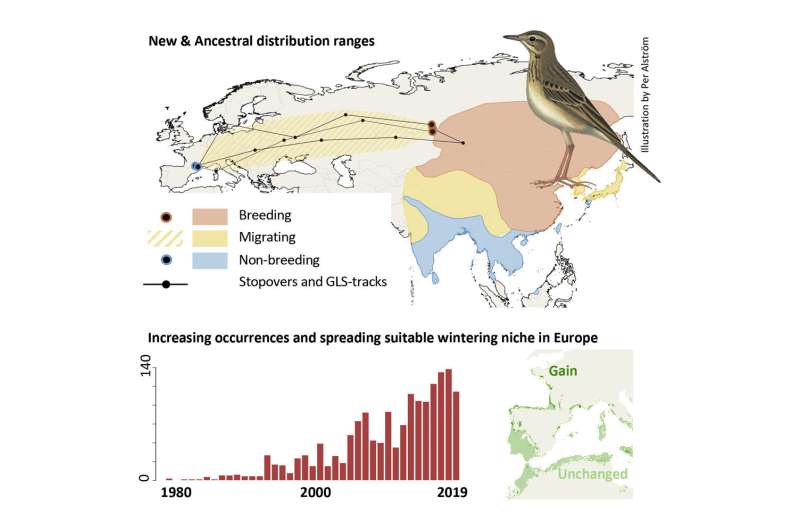Graphical abstract. Credit: DOI: 10.1016/j.cub.2021.09.086
A team of researchers affiliated with several institutions in France has found that vagrancy may play a more important role in changes to migration patterns in birds than has been thought. In their paper published in the journal Current Biology, the group describes their study of data describing the migration patterns of Richard's pipit, a type of songbird that migrates between parts of northern Russia and southern Europe.
Rather than migrating north and south as most birds do, Richard's pipit chooses instead to migrate east and west. Also, recently researchers noted that the birds have been showing up in parts of western Europe where they had not been seen before—evidence of a change in a migration pattern. Evidence of such changes in birds, the researchers note, is rare. Birds generally like to keep their routes stable. The researchers found the change in pattern a unique opportunity to study the factors that push a species to change its migration route.
Historically, Richard's pipits breed in Siberia during the summer and then fly southwest to southern parts of Asia. In recent years, some "vagrants" have been seen in other areas, but their presence has been chalked up to lapses in navigation. But more recently, their numbers have grown in places such as southern France—evidence of a true change in a migration pattern. To learn more about the change, the researchers began collecting data regarding sightings of the birds from both academic and amateur bird-watching groups. They also tagged some of the birds that were found in unusual places to find out if they returned to the new place year after year. They found that most of them did, another sign that the birds were not just lost, but had changed their winter destination home. The researchers note that the change for the birds is particularly notable because unlike many other migration species, they travel alone—thus, they get no cues on landing sites from other birds. They are also unique in that they travel much farther than most other species that migrate east and west. The team suggests more work will need to be done to discover the factors that led to the change, though they suspect it will come down to climate change.
More information: Paul Dufour et al, A new westward migration route in an Asian passerine bird, Current Biology (2021). DOI: 10.1016/j.cub.2021.09.086
Journal information: Current Biology
© 2021 Science X Network























